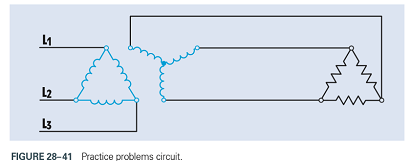

The missing values in the given table.
Answer to Problem 7PP
| EP = 208 V | ES1 = 320 V | ES2 = 120 V | ES3 = 24 V |
| IP = 11.96 A | IS1 = 0.0267 A | IS2 = 20 A | IS3 = 3 A |
| NP = 800 turns | NS1 = 1232 turns | NS = 462 turns | NS = 92 turns |
| Ratio 1 =1:1.54 | Ratio 2 =1.73:1 | Ratio 3 = 8.67:1 | |
| R1 =12 kΩ | R2 = 6 Ω | R3 = 8 Ω |
Explanation of Solution
The transformer in the fig 27-17 contains one primary winding and three secondary windings.
The primary is connected to 480 V AC and contains 800 turns of wire.
One secondary has an output voltage of 320 volts and a load resistance of 12 kΩ.
Second secondary has an output voltage of 120 volts and a load resistance of 6 Ω.
Third secondary has an output voltage of 24 volts and a load impedance of 8 Ω.
The turns ratio of the first secondary can be found by dividing the smaller voltage into the larger:
The turns ratio of the first secondary is re written as,
The current flow in the first secondary can be calculated using Ohm’s law:
The amount of primary current needed to supply this secondary winding can be found using the turns ratio. As this primary has less voltage, it requires more current:
The number of turns of wire in the first secondary winding is found using the turns ratio. Because this secondary has a higher voltage than the primary, it must have more turns of wire:
The turns ratio of the second secondary winding is found by dividing the higher voltage by the lower:
The turns ratio of the second secondary is re written as,
The amount of current flow in this secondary can be determined using Ohm’s law:
The amount of primary current needed to supply this secondary winding can be found using the turns ratio. As this primary has more voltage, it requires less current:
Because the voltage of this secondary is lesser than the primary, it has less turns of wire than the primary. The number of turns of this secondary is found using the turns ratio:
The turns ratio of the third secondary winding is calculated in the same way as the other two. The larger voltage is divided by the smaller:
The turns ratio of the third secondary is re written as,
The secondary current is found using Ohm’s law:
The amount of primary current needed to supply this secondary winding can be found using the turns ratio. As this primary has more voltage, it requires less current:
Because the voltage of this secondary is lesser than the primary, it has less turns of wire than the primary. The number of turns of this third secondary is found using the turns ratio:
The primary must supply current to each of the three secondary windings. Therefore, the total amount of primary current is the sum of the currents required to supply each secondary:
Want to see more full solutions like this?
Chapter 28 Solutions
Mindtap Electrical, 2 Terms (12 Months) Printed Access Card For Delmar's Standard Textbook Of Electricity, 6th (mindtap Course List)
- Since R1=18.10Kohm, R2=67.58Kohm, RC= 1.08Kohm, RE= 3.23Kohm, VCC=14.00V, Beta=241.00 in the circuit given in the figure, calculate the IC current by doing a complete analysis. When performing your operations, 2 steps will be taken after the point. choose the closest one from the stylish ones according to the +/-10% margin of error. There is only 1 correct answer to the question.arrow_forwardPlease show clear and complete solution. Thank you. ASAP! KIRCHHOFF'S CURRENT LAWarrow_forwardThere is a line between two suspension points, A and B, whose elevation difference is 50 m. Point B is higher. The weight of the conductor is 1.83 kg/m and the tensile force at the horizontal tangent point is 4000 kg. The maximum strain on the line shall not exceed 2.5% of the strain value at the horizontal tangent point. Calculate the mast span in this casearrow_forward
- 8/ The shape of the conductor sag in a span is a semi-circle. Select one: True Falsearrow_forwardThe data for a wind turbine is given below: Wind speed = 14 meters/sec, Length of blade = 10 meter Refer to the above wind turbine choose the correct statement a. The wind rotor swept area is 40square meters. b. The wind rotor swept area is 314 square meters. c. The wind rotor swept area is 31.4 square meters. d. The wind rotor swept area is 62.4 square meters.arrow_forwardDetermine I1, I2, and I3 for both circuits shown Please answer in typing format please ASAParrow_forward
- Briefly explain why E = 0 inside a conductor? A conductor is an equipotential’ give your opinion on this statement and explain your opinion. answer must be correctarrow_forwardPlease answer this NEATLY, COMPLETELY, and CORRECTLY for an UPVOTE. Jusr answer letters d, e, f. A cable hangs between two poles that are 80-ft apart. The two poles are both 40 foot high. Sag is observed in the middle of the cable 5 ft from the ground. Find the length of the cable. d. What is the general equation for length of the cable S?e. What are the boundary conditions for finding the total length of the cable S?f. What is the length of the cable S?***Note!For your basis, here are the questions for letters a-c which have already been answered in this link (https://www.bartleby.com/questions-and-answers/cable-hangs-between-two-poles-that-are-80-ft-apart.-the-two-poles-are-both-40-foot-high.-sag-is-obse/552ca7ad-6b18-4584-bd7a-02bbebcb1f20):a. What is the working equation for a catenary forming cable?b. What is the computed constant a up to 4 decimal places?c. What is the catenary equation for the given problem?arrow_forwardSolve for GS/PSarrow_forward
- Given the complex numbers A1=630 and A2=4+j5, (a) convert A1 to rectangular form: (b) convert A2 to polar and exponential form: (c) calculate A3=(A1+A2), giving your answer in polar form: (d) calculate A4=A1A2, giving your answer in rectangular form: (e) calculate A5=A1/(A2*) giving your answer in exponential form.arrow_forwardDetermine whether the following systems are 1. static or dynamic 2. linear or nonlinear 3. shift variant or shift invariant 4. casual or noncasual 5. stable or nonstablearrow_forwardLSI SYSTEM( NEED NEAT HANDWRITTEN SOLUTION ONLY OTHERWISE DOWNVOTE).arrow_forward
 Electricity for Refrigeration, Heating, and Air C...Mechanical EngineeringISBN:9781337399128Author:Russell E. SmithPublisher:Cengage Learning
Electricity for Refrigeration, Heating, and Air C...Mechanical EngineeringISBN:9781337399128Author:Russell E. SmithPublisher:Cengage Learning Power System Analysis and Design (MindTap Course ...Electrical EngineeringISBN:9781305632134Author:J. Duncan Glover, Thomas Overbye, Mulukutla S. SarmaPublisher:Cengage Learning
Power System Analysis and Design (MindTap Course ...Electrical EngineeringISBN:9781305632134Author:J. Duncan Glover, Thomas Overbye, Mulukutla S. SarmaPublisher:Cengage Learning

